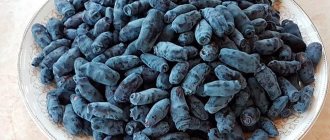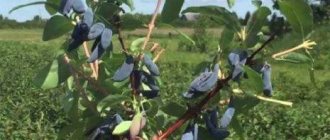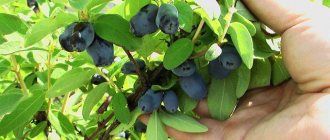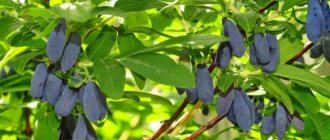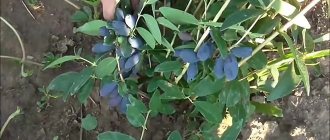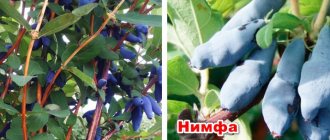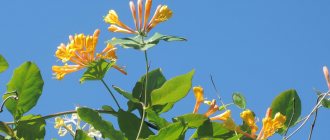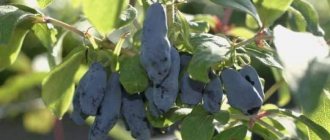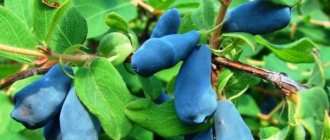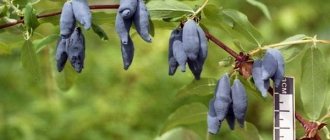Honeysuckle Morena is in demand among gardeners in the northern and western parts of Russia. It is unpretentious in maintenance, rarely susceptible to disease and pest invasion, and tolerates severe frosts well. The breeding and description of the variety was carried out by scientists from the Pavlovsk Experimental Station VIR named after. N. I. Vavilova. It was officially included in the State Register of Breeding Plants of the Russian Federation in 1995.
Description of honeysuckle
Honeysuckle Morena is an edible berry that grows on bushes.
Main characteristics of the variety:
| Bush height, cm | Frost resistance, °C | Ripening time | Productivity, c/ha | Fruiting period, years | Tasting assessment, score |
| 165-170 | 35-40 | mid-early | 50-55 | 20-25 | 4,5 |
Description of the plant:
- Bushes. Quite large in size - up to 170 cm in height and width. The crown is oval and dense. The branches are twisting, thin, flexible, gray-green in color.
- Leaves. They have wide plates, slightly bent in the middle. The color of the leaves is bright green.
- Berries. Large in size, oblong, jug-shaped, blue, covered with a thick waxy coating, which is why they appear blue. The weight of one berry is 1-2 g, reaches one and a half centimeters in diameter, and up to 3 cm in length. The taste is sweet and sour, there is no bitterness. The pulp is tender with a subtle aroma.
Ripening time
In terms of ripening time, Honeysuckle Morena is classified as mid-early. The bush will produce its first fruits in mid-June in northern regions or at the beginning of the month in warmer climates.
The ripening of fruits depends not so much on spring frosts; flowers can tolerate frost down to -6-7 ° C, but on the lack of sunlight.
Productivity and fruiting
Moraine bushes are considered decorative. The yield is assessed as not high - from 1.5 to 2.5 kg of ripe berries are harvested from one bush. Ripe fruits can be stored on branches for a long time without losing their presentation.
Planted bushes begin to bear fruit after 2 years. The berries ripen every year.
The video below provides an overview of honeysuckle "Morena":
The need for pollinators
A feature of the variety is self-sterility. This means that for successful pollination it is necessary to plant pollinating crops nearby, such as:
- Kamchatka moraine;
- Viola;
- Amphora;
- Blue spindle;
- Blue bird;
- Malvina;
- Nymph.
The main requirement for pollinator crops is the coincidence of flowering dates.
There can be 2 planting schemes:
- In groups. When several pollinator plants are planted upwind of several Morena honeysuckle plants.
- Alternating. Pollinator plants are planted between Moraine bushes, alternating them with each other.
Advantages and disadvantages
The advantages of Morena honeysuckle include:
- versatility;
- possibility of widespread growth on the territory of the Russian Federation;
- ease of care;
- frost resistance;
- early ripening;
- ease of harvesting;
- low fruit shedding;
- stable and weather-independent yield indicator;
- excellent taste;
- increased content of nutrients;
- high decorativeness of the plant;
- resistance to pests and diseases.
But there are also disadvantages, such as:
- low yields;
- fruits are not large;
- inability to pollinate.
Recommended Pollinators
The culture is self-sterile. In order to harvest annually, other pollinating varieties should be planted not far from it, which will coincide with it in terms of budding.
Pollinators of honeysuckle "Morena":
- "Blue Spindle";
- "Amphora";
- "Malvina";
- "Viola".
Shrubs should be planted in small clumps, alternating them on the windward side of the pollinated specimen. Then, through the movement of air masses, it will be pollinated.
How to plant Morena correctly?
To ensure that honeysuckle takes root well in a new place, follow the recommendations below.
Honeysuckle Morena tolerates transplantation well at any age.
Selection of planting material
When choosing seedlings, check them according to the criteria for assessing plant health:
- shoots must be elastic;
- branches may be curved;
- internodes must be the same;
- flaky bark is considered normal;
- the root system should not show signs of damage;
- shoots should not be shortened.
If you purchase seedlings in pots, check their root system. To do this, ask the seller to remove the plant from the pot:
- the roots should moderately entwine the earthen ball;
- there should be no signs of mold or rot;
- The plant should have a fresh and pleasant smell.
Selecting a location
When choosing a place where the bushes will grow, pay attention to:
- Territory. Choose a sunny side; in the shade, honeysuckle will also bear fruit, but the yield will be reduced. Plant the plant on a plain, avoid hollows and depressions in which water will stagnate.
- Priming. Despite the fact that honeysuckle is not picky about the composition of the soil, it is better to plant it on loose, slightly acidic soils. If this is not possible, be prepared for the fact that the yield on sandstones will be reduced. And acidic soils will have to be deoxidized. To do this, add dolomite flour or ground limestone into the planting hole.
Bedding
The best time for planting is the last week of September. Morena is planted in the fall. So, by the time spring arrives, it will have time to take root in order to bud in time.
Sequential description of planting:
- Divide the area into rows at a distance of 2-3 m from each other.
- In the rows, mark a place for each bush at a distance of 1.5-2 m between them.
- Dig a planting site with a diameter of 40-45 cm for each bush.
- Pour water into the hole and wait until it is absorbed into the soil.
- Pour compost or manure into the hole in an amount of about 10 liters, you can add superphosphate and potassium sulfate according to the instructions.
- Mix the fertilizer with the soil, forming a small mound of it inside the hole.
- Place the honeysuckle seedling in the hole and spread its root system over the surface of the mound.
- Gently sprinkle with soil, deepen the root collar by 3-5 cm.
- Compact the soil in the hole without applying excessive force.
- Water the planted seedling with 10 liters of water.
- Sprinkle dry soil on top.
- Mulch the planting site, this helps retain liquid inside the soil.
Do not shorten branches before planting - this has a bad effect on survival rate.
Review: Honeysuckle Gardens of Russia “Morena” - The first and long-awaited vitamin berries.
Good afternoon, everyone! Finally, the time has come for the first garden berries to ripen. And these berries are honeysuckle. I have five bushes growing. The very first, and now the largest bush, was planted in 2008. I don’t know what the variety is called, it’s a gift variety. By bending one of the branches, I got another bush of this variety. It's a smaller size for me. The third bush was given to me again. His former owner constantly trimmed the top of his head with a trimmer, and now I have him in a creeping shape. I bought another bush at the market, supposedly the Blue Spindle variety. But, as it turned out later, the bush turned out to be wild with small and bitter berries. I keep it not for its berries, of which there are very few, but as an additional pollinator. But I want to tell you in detail about the fifth bush. Previously, I wrote a review about (Russia, Shibanovo), with which I had some relations. It was there, in 2010, that I purchased a honeysuckle seedling of the “Morena” variety. I was attracted by the very good characteristics of the variety. Here are some of them: 1. Very early ripening of berries. Indeed, it is so. Of my four varieties, the first berries ripened on the third of June on the Morena bush. 2. Harmonious ripening of berries. Almost all the berries were ripe on June 8th. Since the bush is not large, we didn’t collect many berries from it, less than a liter mayonnaise bucket. There are only a few berries left on the bush, only on the lower branches.
3. Large berries. That’s right, the berries are large. Many are 3 cm long.
4. Berries are without bitterness and sweet. Of my four varieties, Morena berries are the sweetest. In terms of taste, I would compare them to blueberries. Other varieties have a sweet and sour taste. 5. Dry picking of berries. Yes, the berries come off easily and without leaking juice. I also like that the berries do not fall off spontaneously. Overripe ones, of course, may fall, but not a significant amount. There are varieties that involve harvesting by shaking off the bush. To do this, you need to put some material under the bush. Now about the seedling that I received from Gardens of Russia. I placed an order for autumn delivery. The seedling was very small. Compared to the currant seedling that I received along with honeysuckle, it was simply a dwarf. Having planted it in the fall, they began to wait in the spring to see if such a little thing would take root? Fortunately for us, the seedling took root, but the growth of branches every year was not large. This is what the bush looks like this year (which is lower).
The crown of the bush grows mainly in width, the structure of the bush is loose, the branches are thin and drooping.
I prefer pyramid-shaped bushes with strong branches looking up. When you look at a transparent bush with berries, it seems that it is strewn with them. In fact, there are not so many of them yet. My bushes are not spoiled with any special care. Sometimes I throw some mineral water under the bushes, it starts to rain. True, this year a bucket of manure humus was poured under all the garden shrubs in the spring. I think the plants are happy. Two days ago, we already collected 7 liters of berries from four of our honeysuckle bushes. Well, this is a photo of all my honeysuckle bushes.
During the ripening period, the bushes have to be protected from birds. Still can’t get around to buying a net. I remember her when the time comes. So we have to use the means at hand. I won’t write about the usefulness of honeysuckle berries; there is enough information on the Internet. I’ll summarize. I give the honeysuckle variety “Morena” from the Gardens of Russia a five-star rating.
Care
Not even the most experienced gardener can cope with the care of Morena honeysuckle. To get a harvest, you only need to provide watering, pruning and timely fertilizing.
Plant care will vary depending on its age.
Young plant
Main components of care:
- Watering. Constant soil moisture is required after planting. Do not allow the planting circle to dry out, otherwise the honeysuckle may become affected by diseases.
- Loosening and weeding. After watering, loosen the soil to provide oxygen to the roots. During loosening and as necessary, remove weeds by removing them along with the root system.
- Pruning. Honeysuckle is not a branched, fast-growing shrub, but begins to grow immediately after the snow melts. Therefore, in the first 4 years, do not prune it, since when shortening last year’s shoots, the developing ovary is cut off, which significantly reduces the yield.
- Feeding. If phosphorus and potassium fertilizers were applied during planting, then for the next 2 years honeysuckle does not need autumn and summer feeding. In the spring, apply a solution of ammonium nitrate or urea under each bush. Continue watering in the snow.
Mature plant
Caring for an adult plant includes the following activities:
- Watering. Produce during dry periods.
- Loosening and weeding. Can be done along with watering and as needed.
- Feeding. Needed on a regular basis starting at 3 years of age. It consists of 4 fertilizer applications: At the beginning of the growing season. As soon as the snow melts or even before that, sprinkle nitrogen fertilizer in the root zone for good development of shoots, flowers and leaves.
- After the harvest. Apply fertilizing with nitrogen, phosphorus and potassium to replace the nutrients spent on the formation and ripening of fruits.
- Before wintering (late summer-early autumn). Apply phosphorus and potassium fertilizers to establish next year's crop. You can use a mixture of 1-2 cups of ash and a few tablespoons of superphosphate.
- Once every 3 years or every year on poor soils. During the period of flower formation, add another feeding. Place a bucket of humus or compost under each bush. You can use slurry, for the preparation of which dilute bird droppings with water in a ratio of 1:7. Leave the solution to infuse for 2 days. Before watering, dilute with water 1:10.
- During the period from 5 to 15 years of growth. Trim only dry, broken, diseased and inward growing branches.
We recommend reading the article on how to care for honeysuckle in the autumn.
Landing Features
Planting honeysuckle of the Morena variety is carried out according to the following scheme: the distance between plants is 2 meters, in row spacing - 3 meters. The landing hole is dug half a meter in diameter and the same depth. 10 liters of humus, 100 grams of superphosphate and about 30 grams of potassium are preliminarily placed at the bottom.
Honeysuckle Pride of Bakchar
The resulting mixture is formed into a mound, on which the seedling is placed and the roots are straightened. The root collar is not buried more than 3 cm. After planting, the young plant is watered with a bucket of water at room temperature and mulched.
Should be considered! Honeysuckle grows in one place for up to 25 years, so the choice of place where to plant the shrub is approached responsibly.
In the first 4 years, Morena honeysuckle is not pruned or formed
As for the choice of soil, the plant is unpretentious and produces a harvest even on depleted soil, but its quantity is noticeably reduced. It is better to plant honeysuckle in a sunny area, protected from drafts and winds. In this case, the fruits are larger and sweeter. Planting is carried out at the end of August-September, because the growing season of honeysuckle begins very early. In spring, survival rate is much worse.
Diseases
During damp and cold summers, Morena honeysuckle can be affected by fungal diseases such as:
- Powdery mildew. Whitish spots appear on the plants. Over time, droplets of liquid appear on them. A wide range of drugs are used: Zato, Rayok, Tilt, Topsin, Fundazim, Bayleton, Quadris, Skor, Topaz, Thiovit Jet and Fundazol.
- Plant rust. Pustules of various shapes are formed on the leaves, the color of rust. When they are destroyed, powder of the same color spills out. It is treated with drugs Abiga-Pik, Cumulus, Polyram, Strobi or others, which contain sulfur.
Treatment is carried out only after the appearance of ovaries or after harvesting.
Since diseases are rare, no preventive measures are taken to prevent them.
Reviews from summer residents
- In my opinion, this is the best variety of honeysuckle. I've been growing it for about five years. It is possible to collect from 2 to 3.5 kg. berries with great taste. The fruits are large. The bushes pollinate well only when there are other honeysuckle plants in the neighborhood. The variety overwinters well. Practically, he doesn’t get sick. Good variety.
- The variety is simply amazing. The berries are large, beautiful and very tasty. In all this time, only one year the variety fell ill with powdery mildew. And everything is fine. I collect up to 2-2.7 kg. berries from the bush. The variety loves proper pruning and watering. Even in a shaded place you can get good yields.
- The variety has been growing in my dacha for more than seven years. During this time the bushes never hurt. Among the pests, aphids have been pestering us for several years in a row. But a few sprays were enough to solve the problem. Plants of this variety winter well and quickly begin to grow in the spring. The harvest is stable - up to 2 kg. berries from the bush.
- Honeysuckle is my weakness. I grew many varieties at the dacha, but out of more than 20, I kept only this one. Why more? Yields are high. Up to 3.6 kg. from the bush in some years. There are no special requirements for cultivation. Winter hardiness is excellent. The variety is not susceptible to diseases. In a word, I’m happy with the variety, and I’m not going to change to another.
Pests
Old plants are quite resistant to pest attacks, but young shoots can be affected by:
- Aphids. It appears in the presence of curled, dry leaves that fall off over time. The bush changes color to brown, insects can be seen with the naked eye. If a pest is detected, treat the plant with Actellik or Confidor.
- A leaf roller butterfly. The danger comes from its caterpillars, which suck the juice from the plant. Leaves rolled into a tube appear on the bush, tied together with cobwebs. Over time, the plant turns yellow and dries out. The drugs Dimilin and Fitoverm will help in the fight against this pest.
- Willow scale. A very rare, but still common, lesion of plants under the bark. Bumps appear on the surface of the branches, shaped like a comma. Fitoverm will come to the rescue in the fight.
- Spider mite. First, the pest settles on the bottom of the leaf, and small white dots appear on the top. Over time, it moves to the top of the leaf, and the plant becomes covered with cobwebs. You can fight the pest using a solution of laundry soap. If the damage is extensive, it is better to treat the bush with insecticides - Vertimek, Fitoverm, Aktofit.
Treatment is carried out only when parasites are visually detected. The plant is sprayed 2-3 times with an interval of 10-14 days.
During the ripening of the crop, only folk remedies or biological preparations are used.
Honeysuckle pests and protection against them.
Honeysuckle leaves can be damaged by aphids. If you find aphids, then one of the effective safe methods of combating them is to dip the stems with aphids in a solution of soapy water. It is permissible to use chemicals only after picking the berries.
Honeysuckle damaged by aphids
A more insidious pest is the honeysuckle borer, a small beetle that lays eggs in the stem of honeysuckle. The hatched larva lives inside and feeds on the wood, destroying the shoot. The first sign of the pest is that the leaves on the stem grow small, much smaller than on healthy branches.
Damage to honeysuckle borer, adult beetle and larva.
Therefore, dried shoots must be cut down to healthy wood and burned to prevent the borer from reproducing. This should be done upon detection, without waiting for autumn.
Birds, such as blackbirds, love to peck honeysuckle. A special fine-mesh net stretched over the bushes will help protect the berries from birds.
Reproduction methods
The best ways to propagate honeysuckle are:
- Dividing bushes. They dig up the ground in the part where young shoots have formed. From the peripheral part of the root system, young roots with shoots are separated from the central root to obtain a young bush.
- By layering. The branch is covered with earth, leaving only the top on top. After the root system has formed in the lower part of the branch, it is carefully separated from the main bush.
Methods of propagation from seeds and cuttings do not give positive results. Since germinated seeds do not retain varietal characteristics, and cuttings do not take root well.
Collection, storage and processing
The harvest is harvested in 2-3 doses every other day, focusing on the ripening of the berries.
Fresh fruits are very useful to eat without additional processing - Morena contains many useful substances: pectin, tannins, organic substances and acids, magnesium, iron, copper and many other substances.
Since it cannot be stored for a long time - only 2-3 days in the refrigerator. It is processed:
- Grind with sugar. Can be stored in the refrigerator all winter.
- Fruit juice is being prepared. Can be stored in a cool place for several months.
- Making jam. The delicacy has a bright taste.
- Dry it. Afterwards, you can add the berries to tea or compote.
- Freeze. Moraine does not flow and does not change shape after defrosting.
Reviews from gardeners about honeysuckle Morena
★★★★★
Ekaterina, 40 years old. In our garden, Morena honeysuckle grows along with pollinators - Long-fruited and Kamchadalka.
The bush is well developed, but there is no size of 170 cm, the maximum is 140. Perhaps this is because we have a warm climate. The berry itself ripens well, is large, and tastes sweet. ★★★★★
Elena, 50 years old. Of all the varieties of honeysuckle, of which I have 10, Morena seemed the sweetest and most dessert-like.
Wintered well. This year, despite the dry weather, I was pleased with the harvest of large berries without bitterness. Compared to other varieties, it had the least amount of dry branches. ★★★★★
Daria, 43 years old. I have a Morena honeysuckle bush growing.
It bloomed early this year, not many berries were ripe, I think this is due to autumn replanting. In general, our berries are not large, but very tasty, reminiscent of blueberries. Hide
Add your review
The honeysuckle variety Morena is an early variety, tolerates winter well, and was bred specifically for cultivation in the climatic conditions of the North. The plant does not require any special growing conditions and is resistant to diseases and pests. In addition, the decorative and attractive bush will become a real decoration of the garden.
0
0
Copy link
Characteristic
In addition to the appearance of the Malvina honeysuckle bushes and fruits, other characteristic features of the plant deserve no less attention, which directly affect the characteristics of its cultivation.
Frost resistance and drought resistance
It is not for nothing that the hybrid honeysuckle Malvina is recommended for cultivation in any region of the Russian Federation: the shrubs can withstand low temperatures well, and if the substrate is regularly moistened, they are not afraid of heat. In the northern regions of Russia, the plant is not afraid of temperature drops down to -50°C; however, for this you will have to cover the above-ground part with agrofibre.
The root system of honeysuckle is more vulnerable, so when it reaches -40°C it quickly freezes. Flower buds can withstand the effects of return frosts within -8°C, but with a further decrease in indicators they will die.
The crop's resistance to long-term drought is not so high, therefore, when cultivating honeysuckle in the southern regions, you will have to control the level of soil moisture, especially during the period of flowering and fruiting of the bush. Insufficient watering may cause the berries to become crushed and reduce their taste.
Fruiting, productivity
With proper organization of the conditions for growing honeysuckle Malvina, in central Russia the fruits can be harvested as early as the end of June, although if you leave them on the bushes for a few more weeks, they still will not fall off (separating the fruits from the stalks here is more difficult than with other similar varieties).
The yield of the variety is average or slightly above average, since up to 3.2 kg are harvested from one bush, and about 48.9 centners of berries are obtained from 1 hectare.
Advantages and disadvantages
Like any other variety, edible honeysuckle Malvina has its strengths and weaknesses.
- The list of advantages of the plant includes the following characteristics:
- large fruit;
- low tendency to fruit shedding;
- high taste characteristics of berries;
- high resistance to low temperatures, diseases and pests;
- early fruiting and good productivity.
As for the disadvantages of growing Malvina, it has no significant disadvantages - of course, if you do not take into account the requirement for regular watering in dry summers and the slight difficulty of separating the berries from the stalks. However, not all gardeners consider this last feature a disadvantage, especially if we remember the low tendency of the variety to shed fruit.

